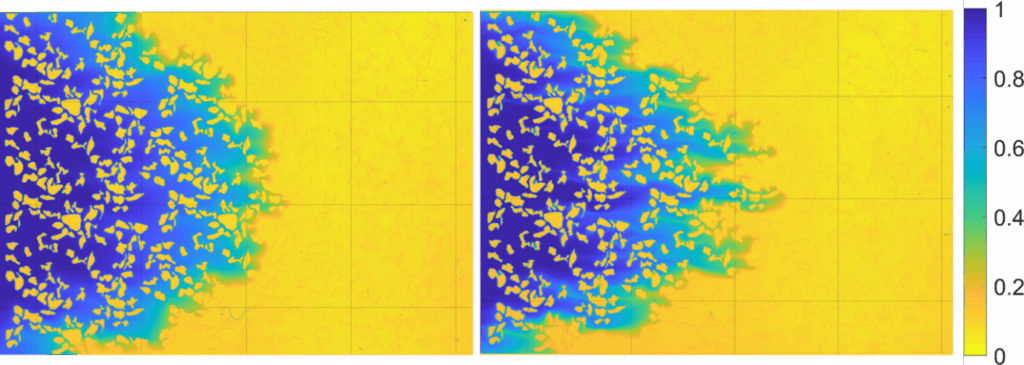Transport of solute species is a common occurrence in various environmental and industrial applications, including, but not limited to, storage of hazardous substances (e.g., CO2) in deep geological formations and pollutants transport in groundwater and soil vadose zone (Figure 1). In many of these processes transport happens under multiphase, e.g. water and air, conditions strongly affecting transport in geological porous media (e.g., rock and soil).
Under multiphase conditions, transport process depends on the interplay of two key mechanisms: 1) spatial distribution of water and air within rock and soil, and 2) relative importance of advective and diffusive forces within the solute carrier phase (water), both of which can be impacted by multiple parameters such as porous media characteristics and applied boundary conditions. A sound understanding of transport processes within soil and rock is essential for, e.g., developing effective remediation and cleanup strategies in contaminated underground aquifers, as well as evaluating the leakage risks associated with hazardous substances. As opposed to single-phase scenario, the migration of pollutants under multiphase conditions received limited attention, mainly attributed to challenges in determining the spatial distribution of the fluid phases. In recent decades there has been a surge in sever environmental events such as flooding where alteration in dynamic conditions, i.e. changes in the rate of infiltrated water, can impact the fate of contaminants by changing the structural heterogeneity of underground porous media and disturbing the pre-existing water-air interfaces.
The main objective of this PhD research is to identify and quantify the key mechanisms governing transport under varying boundary conditions, using both experimental and numerical models at the pore scale. In addition, the influence of structural heterogeneity in porous media, and its combined effect with varying boundary conditions, on transport will be investigated. The insights gained from this project will enhance our understanding of solute species transport in underground systems. By improving our ability to understand and quantify transport processes in geological porous media, this project will drive meaningful progress in environmental protection and climate resilience.
Figure 1: Effect of water infiltration rate on solute species transport in porous media. (Left) Low flow rate. (Right) High flow rate.

This project is not suitable for CASE funding
Each host has a slightly different application process.
Find out how to apply for this studentship.
All applications must include the CENTA application form.
Choose your application route
Physical data will be generated through microfluidic experiments employing soft lithography and 3D printing techniques, while direct simulations will be used to produce numerical data. High performance computing clusters along with clean room facilities at Warwick University will be employed for preparing numerical and experimental results. We will model the impact of severe environmental events by applying multiple cycles of water and air into representative porous media with different degree/type of heterogeneity for various durations and magnitudes. Dyed fluid phases and image analysis algorithms will be used to determine the spatial distribution of fluid phases, while migration of solute species will be done through numerical modelling, remarkably reducing the computational expenses of simulations. To do so, output of experimental results will be fed into simulations to construct numerical domains. Navier-Stokes equation will be coupled with advection-diffusion equation to model the migration of solute species within available pathways for transport process.
DRs will be awarded CENTA Training Credits (CTCs) for participation in CENTA-provided and ‘free choice’ external training. One CTC can be earned per 3 hours training, and DRs must accrue 100 CTCs across the three and a half years of their PhD.
This research project provides comprehensive training in environmental science and computational modeling disciplines, covering topics such as environmental modeling, pollution transport and water quality modelling, advanced data science and predictive modeling, remote sensing, and field-based data collection. The successful applicant will gain practical experience of high performance computing and developing computationally efficient CFD algorithms. Training on analysis and modeling of large datasets will be provided to facilitate developing robust data collection and sharing protocols for developing robust computational fluid dynamics models.
This project will benefit from collaboration with the University of Manchester and Swedish Environmental Research Institute.
Year 1: Fundamental research skills training will include a comprehensive literature review and hands-on experience with soft lithography and 3D printing techniques, along with associated software such as CAD and 3D computer graphics tools. Additionally, the project will involve developing computational methodologies for simulating flow and transport in porous media using OpenFOAM open-source libraries.
Year 2: Comprehensive laboratory experiments will be conducted to characterise the spatial distribution of water and air under varying dynamic conditions in heterogeneous porous media. Calibration and validation of numerical model will be done based on microfluidic experiments for simulating solute transport in porous structures.
Year 3: In-depth analysis of experimental and numerical data based on produced results and thesis write-up.
1) Saeibehrouzi, Ali, et al. “Solute spreading enhancement by drainage-imbibition cycles in unsaturated porous media.” Water Research (2025): 123741.
2) Saeibehrouzi, Ali, et al. “Solute transport in unsaturated porous media with spatially correlated disorder.” Advances in Water Resources 191 (2024): 104773.
3) Hasan, Sharul, et al. “Direct characterization of solute transport in unsaturated porous media using fast X-ray synchrotron microtomography.” Proceedings of the National Academy of Sciences 117.38 (2020): 23443-23449.
4) Jiménez‐Martínez, Joaquín, et al. “Pore‐scale mechanisms for the enhancement of mixing in unsaturated porous media and implications for chemical reactions.” Geophysical Research Letters 42.13 (2015): 5316-5324.
For informal inquiries about this project, you can email Dr Soroush Abolfathi ([email protected]).
To apply to this project:
Applications must be submitted by 23:59 GMT on Wednesday 7th January 2026.